Porsche’s Le Mans was a true show of perseverance, and their race, in the various classes, could be best described as an “ebb and flow”. The thing that is always true about the 24 Hours of Le Mans, first and foremost, is that it is a very long race, and a lot of things can happen. This is true both for you, as well as for your competitor. The important takeaway from that fact is that you should never hang your head or wring your hands in defeat before you have been defeated. Any number of terrible things can happen to those cars nominally ahead of you on the timing charts, and you can soon find yourself back at the top. The flip side of the coin is that you should never allow yourself to be lulled into a sense of security, as your competition could bounce back and attack at any given moment. The race isn’t over until it is over, and nowhere is that more true than in a 24 hour race at Le Mans.
Porsche Video News “The return” – 24h Le Mans from Porsche AG on Vimeo.
Prior To The Start Of The Race
Before the race even started, it was certainly shaping up to be a race of high attrition rate. There were a number of cars that were shunted in the lead up to the start. A few issues in the practice and qualifying sessions set the stage for how Porsche’s 24 hour would proceed.
A rebuild for Bergmeister’s #91 GTE Pro Porsche after a huge off at the Ford Chicane in the pre-race test would mean that the factory team would be on the back foot with minimal running headed into the race.
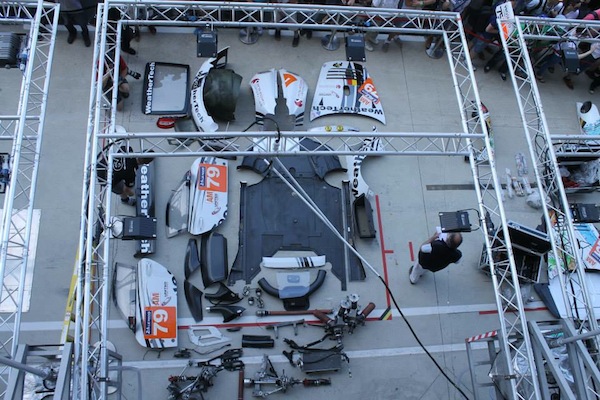
One of the biggest stories of Thursday’s practice sessions, however, was the massive shunt for the Prospeed/Weathertech racing that completely wrote off their 997 GT3 RSR tub as useless. They managed to find a spare 997 tub to rebuild the car from, however driver Bret Curtis was not able to be cleared to run the 24 hours with the team. The solution, they thought, was to bring in a replacement driver in the form of French driver Sebastien Crubile. Unfortunately, as the car was not repaired until Friday morning, Crubile was not able to complete his required night-time practice laps, and wasn’t cleared to drive. Without many other options, drivers Jeroen Bleekemolen and Cooper MacNeil determined that they could run the entirety of the 24 hours with just the two of them driving. As both drivers are considered “pro”, the car was moved into the GTE Pro category for the race.
The Early Hours
From starting positions of second and fourth, Porsche’s 919 Hybrid teams took off at 3PM on their way toward the next day, but it was easily seen that their race opening pace was well down on that of the Toyota and Audi crews. It wasn’t long before Porsche was tumbling down the order, and found themselves not only behind both Toyotas, but also behind all three Audis. While not something to particularly be worried about, after all it is a long race, it certainly gave show to the fact that Porsche’s single lap pace was a second or two short of what the Audi and Toyota could manage. If anything was to be done, it would have to be done on reliability, long fuel stints, and taking care of their tires.

In GTE, things were not a lot better, as there was consistently a number of cars ahead of the Porsche contenders, but they did manage to keep the field in sight. In fact, for the first hour or so, the top 10 in GTE Pro were practically nose-to-tail, making for some rousing racing.
And Then The Rain Came
Things sort of settled out for a little while, but all of that was thrown away completely when the rain decided to fall. All of the teams were bouncing back and forth between Michelin slicks and wets, trying to play the weathermen and get the predictions right. The strange thing about that bit of rainy section was that it was over almost as soon as it had begun.
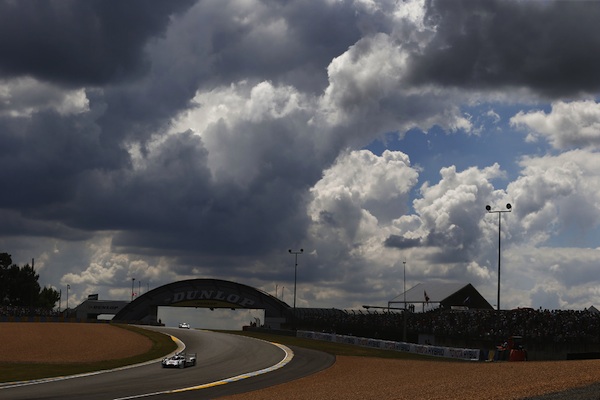
In one fell swoop, two of Porsche’s competitors were cut from the leading pack, as the #8 Toyota TS040 and the #3 Audi R18 suffered collision with a GTE Ferrari. The Toyota was badly wounded, but was able to make it back to the pits for repairs. The Audi, however, was not so lucky, and was forced to retire when Marco Bononomi could not get the car back moving again.
The rain, the only rain of the race in fact, came right before 5PM local time. The rain came down in fits and starts, as it would drizzle, then bucket down, then get sunny again before starting the cycle again 2 or 3 times. In changing weather, many of the competitors pitted a number of times to change tires. Patrick Long, though, pulled off a killer drive in damp conditions on slick tires in the Dempsey Racing car, losing a handful of minutes to the competition, but gaining them all back when everyone else had to move back to slicks from their wet weather tires. Each of the drivers of the Dempsey car drove a heck of a weekend, but a punative penalty for a pit-lane burnout on exit cost them a lot of time in the middle of the race. For a while, the #77 GTE-Am car was ahead of the GTE-Pro leaders because of the drivers’ Herculean efforts.
Only Three Hours In
It’s only just before the three hour mark into the race when the Porsche 919 Hybrid #20 (Webber, Hartley, and Bernhard) take over the lead. This moment is significant because it has been 16 years since a Porsche racing car has led the 24 hour race overall. Being that Bernhard was in the car at the time only adds to the mystique of the event, as Bernhard is one of the hardest working drivers in the sport, and a true Porsche fanatic/scholar.
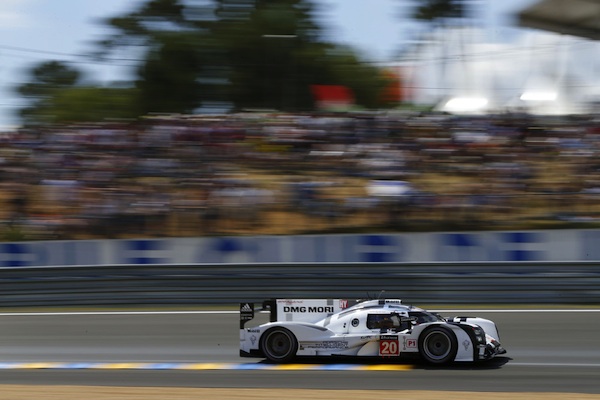
Even more significant than Porsche leading overall, just a few minutes later, exactly 3 hours into the race, Porsche’s #20 was leading overall while Porsche’s #91 car in GTE-Pro, with Bergmeister at the wheel, and the #77 car of Pat Long lead in GTE-Am led their classes respectively. Leading three classes all at one time is not an easy feat.
Things stayed in lock step for about 45 minutes, but the #20 was passed for the lead by one of the remaining Audis, but regained the lead when the Audis pitted for fuel. Regaining the lead, the #20 then had to fight off pressure from the #7 Toyota. The 91 Porsche had been overtaken by Tommy Milner’s #74 Corvette, and the Corvette began to stretch a lead.
The #7 Toyota retook the lead of the race from Porsche at just after hour 4, but the Porsche maintained a tight gap to Sarrazin’s Toyota. Perhaps 10 to 15 minutes early, the lead-pack #20 had to pit because Hartley thought there may be a punctured tire, costing them valuable time. They resettled into the race in third, and try to maintain a pace to the leaders.
Porsche’s braking issues started showing up at about hour 5. Brendon Hartley missed his braking point into the first Mulsanne chicane. In a later interview with reporters, Webber mentioned that the #20 car was attempting to “manage” an issue, but would not go into further detail when probed.
Quarter Distance
By this point, Porsche was trying to maintain the lead lap while the #7 Toyota galloped off into the distance. As the light started to slip away at the circuit, Brendon Hartley ran straight at the runoff area exiting Arnage before getting started up again and returning to the pits for a driver and tire change. Mark Webber, stepping behind the wheel in competition at Le Mans for the first time, managed to find a rhythm quickly and get things underway again.
The Prospeed/Weathertech two-driver 997, by this point, had already suffered from two left rear tire punctures, but their ironman stints just kept coming, and they managed to keep the car relatively stable. While not near the pace of the leading GTE Pro cars, they were running a good race, and managing quite nicely.
Aston Martin was dominating proceedings in the GTE categories at the time, leading both classes by a relatively comfortable margin.
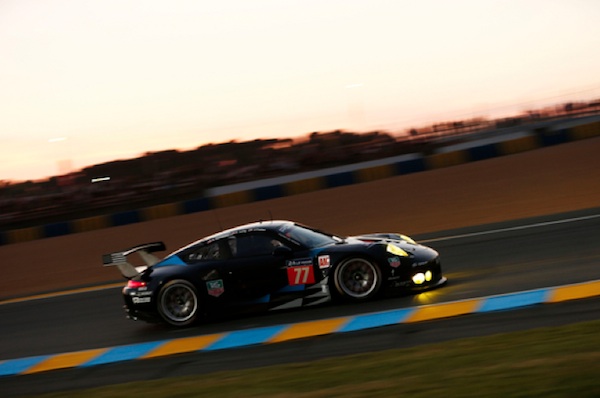
After darkness had descended upon the circuit in its entirety, the #77 GTE-Am Dempsey Racing entry came in for a pit stop and a driver change. I don’t know the story complete, but I believe Patrick Dempsey had just gotten out after a double-stint, and Joe Foster was stepping behind the wheel. Apparently having forgotten about the pit-lane rule against burnouts exiting the pit lane, Foster committed a lurid spin of his giant rear Michelins as he dropped off of the air jacks. This spin of the tires caused Foster to incur a punitive 3 minute penalty on his very next lap. (If you’re reading this, Joe, we think it’s a dumb rule, too.)
Not to be outdone in pit-lane penalties, the #67 IMSA Performance Porsche was given a stop and hold penalty for speeding in the lane.
At just after the turn of the 8th hour, Mark Webber’s #20 car went off at the exit of Arnage again in the same fashion that Hartley had done earlier. He got the car going again, and drove away. Only half an hour later, Neel Jani put the #14 Porsche in the same place, going straight on at Arnage. Being the third professional Porsche driver to commit that error, it was starting to become clear that there was some issue under breaking, perhaps with the energy recovery system.
Midnight
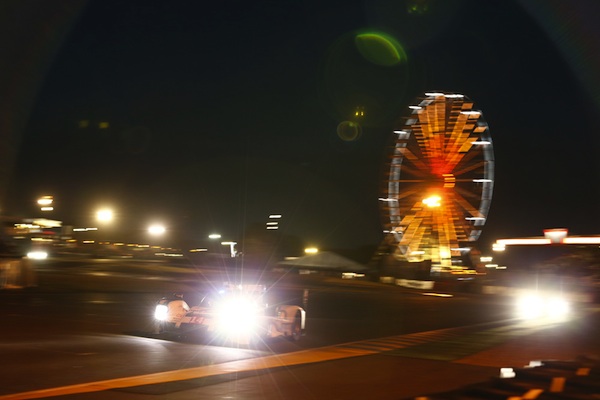
Just after 12:00, the #91 Team Manthey Porsche 991 RSR pitted with a misfire issue that was costing them several miles per hour on the straights. The source was determined to be a fuel pressure issue, and a lengthy repair of the car was committed to replace the entire fuel cell. In all, they lost 19 minutes in the garage. They thought all was well, but just one lap later, the #91 returned to its garage stall.
Webber hands the #20 car back to Timo Bernhard after a relatively calm stint at the wheel.
At almost 2 in the morning, the #75 Prospeed Porsche was wheeled into the garage for repair.
At three o’clock in the morning, the 20 Porsche is sat in 4th position overall when the #1 Audi in third slows dramatically. With Kristensen in the car, the #1 pulls off the circuit into the pits, and is swiveled immediately back into the garage. The Audi team commits to a fuel injector swap, and sends the car back out with Lucas Di Grassi at the helm. After only a handful of laps, Di Grassi swings back into the pits with a puncture, losing even more time. The #20 Porsche now has a commanding gap over the #1 Audi.
The #14 Porsche is plagued with fuel-pressure issues, and has continually been running slower laps than the #20 sister car, as well as the rest of the LMP1-H field.
Hour Fourteen – The Toyota Expires
With 10 hours remaining in the race, and after having been in the lead for what feels like a decade, the #7 Toyota slows to a crawl near the end of the Mulsanne straight, and ducks behind a wall just off the course at Arnage, and retires. The crew stands incredulous staring at the monitors, and the car is said to have suffered a small electrical fire, and the engine will not re-start. The #2 Audi, only a minute and a half behind the Toyota, nips into the lead for the first time all race. How great is it to have a 24 hour endurance race in which three different manufacturers lead the race overall? Something we have not seen at Le Mans for many years.
The #92 Porsche GTE-Pro car limps back to the pits from 3rd on track at just before sunrise. Presumably with a punctured tire, as they drove away with a driver change and no further issues.
The #20 LMP1 Porsche with Brendon Hartley aboard goes straight on at Indianapolis, and cannot get restarted. With a push out of the gravel, the car is able to get started back up and underway again. The car lost about 5 minutes in the kerfuffle, but everyone is safe, and the car appears undamaged. Within an hour and a half or so, this same problem happens three more times across both LMP1 entries. This simply seems to confirm the intermittent brake issues that the Porsche 919s have had up to this point, as a grouping of drivers of this caliber would not continually make the same mistake.
Since the Toyota’s retirement, Audi #2 has lead by about 3 laps from the #2 Audi in second and the #20 Porsche in third. The Porsche runs consistently slower than the Audis, but is staying within shouting distance of second place. Goonies never say die, remember?
Hour 16 – Audi Drama
2 hours after the leading Toyota’s issues, the leading Audi #2 runs into trouble. The car pits, and is immediately pulled into the garage. The team fiddles with some bits at the back of the car, losing precious seconds of their 3 lap lead, then push the car back onto pit-lane to start it up and get it back going. Le Mans rules specify that all cars must start under their own power, but the Audi will not turn over and catch. The team then pulls the car back into the garage and put it up on the high-jacks. It appears that a turbocharger replacement is in order. The team lost a monsterous 21 minutes in the pits, and along with it, the lead. From 3 laps ahead, the car finally emerges just over 2 laps down. In their favor, the track was under localized cautions during their change.
Hour 20 – More Audi Drama
After leading the race for four hours, the #1 Audi of Tom Kristensen comes to a stop on the Mulsanne just after the first chicane. A cycle of the electrical systems, and he’s back going, but not up to speed. A quick stop in the garage and the car is back out… For one lap. Kristensen pulls back into the pits, and the car goes into the garage. Confirmation soon comes that the #1 has suffered the same fate as the #2, and a turbocharger change is required.
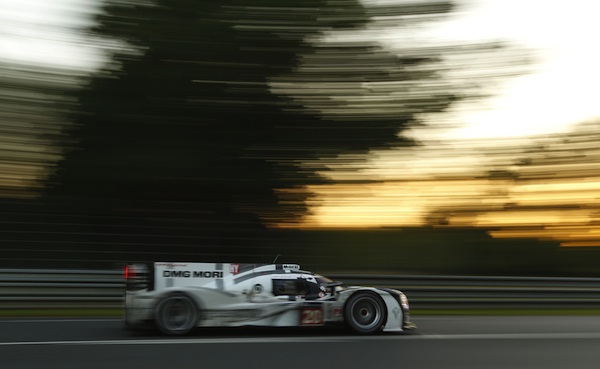
Porsche #20 is back in the lead at hour 20! Slowly but surely, over the last four hours, the #2 Audi has been eating into the gap to #20 Porsche, and at the time Porsche retook the lead of the race, the #2 was only about a minute and a half back. A real dogfight has truly begun, and some of the most exciting racing I’ve ever seen took place over the following hour.
The #1 Audi lost only 17 minutes in the pits, and rejoins the race only 3 laps down.
Hour 21 – Porsche Drama, The Race Is Over
Sadly, Porsche only had 1 hour of glory before an ignominious defeat. The #20 car, with Mark Webber at the wheel, was dramatically slower than the Audi (which was ahead on pit sequencing). The Audi was eating Webber for lunch, extending their lead by 5-7 seconds per lap, and the #20 was clearly walking wounded. At almost exactly the 21st hour mark, the car slows to a crawl coming out of the first Chicane on the long Mulsanne straight. Unfortunately, the car could not accelerate, and was pulled into the garage when Webber finally coaxed it back around to the pits. The car was torn down, investigated, reassembled partially, and investigated further, but unfortunately the #20 would never leave the garage again.
Porsche Video News “Le Mans Highs and lows” – 24h Le Mans 2014 from Porsche AG on Vimeo.
Just an hour and a half after Webber’s retirement, the #14 sister car comes into the pits with what appears to be a similar issue. Later Porsche would report that the #20 had a “driveline issue”, and that the #14 was a “gearbox issue”. The 14 car was sent back out at the end of the race, having been fixed before the checkered flag
Hour 24 – The Finish
LMP1 – Unfortunately, the rules at Le Mans require your car to be running on the final lap, and to complete that lap in under 6 minutes 30 seconds in order to be included in the final results. Being that the #14 garage is located after the start-finish line, their official time for the final lap was over an hour and a half in duration. Because of this mis-step, neither the #20 or the #14 were finishers at Le Mans this year.
GTE-Pro – The only saving grace for the Porsche four-car official team was the #92’s third-placed podium finish in GTE. Team newcomer Fred Mako worked well with Marco Holzer and Richard Lietz to fight through all of their issues to end up on the shortest step. The #91 car’s fuel pressure issues pretty much knocked it out of contention for any kind of result, and they finished some 30 laps down to the class winner.
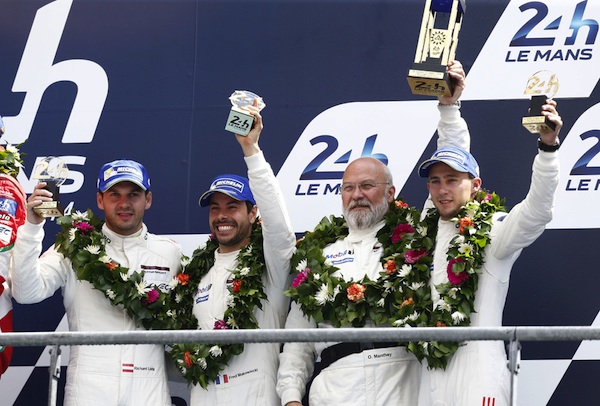
In a true showing of iron-man dedication, the #97 of Cooper MacNeil and Jeroen Bleekemolen managed to come home in 5th in the GTE-Pro category. Somehow, through sheer will of determination, they overcame a handful of punctured tires, a completely rebuilt chassis, and an old-school two-man driver lineup, to finish well above some of the more seasoned and more prepared factory efforts. As they were planning to run in the GTE-Am category until their amateur driver was injured in the wreck that took out their chassis, they were using an older 997 GT3 chassis, and it was literally assembled in the hours on the Friday morning before the race in order to make scrutineering. Fantastic job to the drivers, as well as the Prospeed Porsche team that made it all work.
Final Results of GTE-Pro Class
1. Bruni/Vilander/Fisichella (I/SF/I), Ferrari 458 Italia, 339 laps
2. Magnussen/Garcia/Taylor (DK/E/USA), Chevrolet Corvette, 338
3. Holzer/Makowiecki/Lietz (D/F/A), Porsche 911 RSR, 337
4. Gavin/Milner/Westbrook (GB/USA/GB), Chevrolet Corvette, 333
5. Bleekemolen/MacNeil (NL/USA), Porsche 911 GT3 RSR, 319
6. Turner/Mücke/Senna (GB/D/BRA), Aston Martin Vantage, 310
7. Bergmeister/Pilet/Tandy (D/F/GB), Porsche 911 RSR, 309
GTE-Am – Perhaps surprise is the wrong word when describing the Proton Competition Porsche #88’s second place GTE-Am category finish. The thing about that car, however, is that it was almost unheard from for the entirety of the race. That’s how you win this race, though. Don’t do anything remarkable for 23 and a half hours, and you’ll likely be in position for a good run to the end. This is precisely what Bachler, Reid, and Al Qubaisi did in their 991 RSR, they kept their nose clean, kept out of the pits, and managed to put together a very respectable finish.
The other Proton car, run in conjunction with Dempsey Racing, didn’t do too bad of a job either, but never did manage to recover after their 3 minute penalty from the pit-exiting burnout by Joe Foster. The car was quick all weekend, and Dempsey himself has certainly picked up the pace from year to year. Using the newest chassis really worked well for them, and seemed to be quick, confidence inspiring, and easier to drive in comparison with the 997s they’ve driven in the past.
GTE-Am Class
1. Poulsen/Heinemeier-Hansson/Thiim (DK/DK/DK), Aston Martin, 334 laps
2. Ried/Bachler/Al Qubaisi (D/A/UAE), Porsche 911 RSR, 332
3. Perez-Companc/Cioci/Venturi (RA/I/I), Ferrari 458 Italia, 331
4. Montecalvo/Roda/Ruberti (I/I/I), Ferrari 458 Italia, 330
5. Dempsey/Foster/Long (USA/USA/USA), Porsche 911 RSR, 329
6. Dalla Lana/Lamy/Nygaard (CAN/P/DK), Aston Martin Vantage, 329
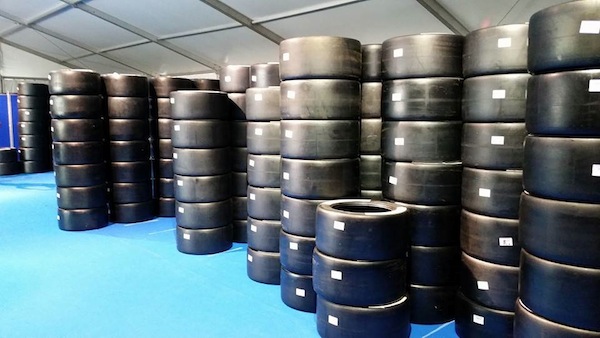
This trip was made possible thanks to Michelin and their sponsorship of our visit. We have many more stories to come, including some behind the scenes stuff you won’t see elsewhere and more pictures than you can imagine. Thanks again to Michelin for making this such a special trip.
Other Porsche Blog Posts You Will Enjoy
A Few Of Our Pictures From The 24 Hours Of Le Mans
Porsche At Le Mans: The Definitive History